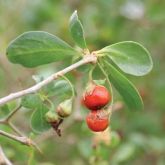African boxthorn

African boxthorn fruit
© Queensland Government

African boxthorn plant form
© Queensland Government

African boxthorn leaves
© Queensland Government

African boxthorn plant form close-up
© Queensland Government

African boxthorn flower
© Queensland Government

African boxthorn plant
© Queensland Government

African boxthorn fruit close-up
© Queensland Government
Native to southern Africa, African boxthorn is a spiny shrub introduced to Australia in the mid 1800s as a hedge plant. It has since spread to pastures, neglected areas, roadsides, railways and waterways. African boxthorn produces dense, spiny thickets that can form impenetrable barriers to stock and people.
You must manage the impacts of African boxthorn on your land.
You must not give away, sell or release African boxthorn into the environment.
Scientific name
Description
- Perennial shrub up to 5m tall with deep, extensive, branched root system.
- Stems are rigid, branched, woody, thorny.
- Leaves are bright green, 3cm long, 2cm wide, rounded at top, tapered to base.
- Flowers are white to pale mauve, 12mm diameter.
- Berries are smooth and green when young, ripening to bright orange to red.
- Seeds are numerous, light brown, oval, flattened.
Habitat
- Prefers better soils of Maranoa and Darling Downs districts, where it is an aggressive weed.
- Grows on all soil types but establishes better in lighter soils, particularly along dry creek beds.
Distribution
- Visit Weeds Australia and click on the distribution tab to access the distribution map.
Life cycle
- Seeds may germinate at any time of year, and quickly establish a root system to allow young plants to compete with other species.
- Plants are at least 2 years old when they first bear flowers, generally in summer.
- Flowering and fruiting may occur at any time throughout the year.
Impacts
Environmental
- Invades reserves and conservation areas.
Economic
- Aggressively invades pastures and reduces useability.
- Invades roadsides.
- Forms impenetrable, spiny thickets, which can hinder stock movement and mustering.
- Provides habitat for pest animals such as rabbits.
- Attracts insects, including fruit fly, dried fruit beetles and tomato fly, which breed in the fruit.
Social
- Forms impenetrable, spiny thickets that can hinder bush walking.
How it is spread
- Spread by birds and animals eating berries and excreting viable seed.
Prevention
Control
Physical control
- Hand-pull young plants.
Mechanical control
- Clear large stands of boxthorn by dozing, stick raking or blade ploughing.
- Control regrowth from seed or remaining roots using cultivation and herbicides.
Herbicide control
Foliar spray
- Spray entire bush to point of run-off.
- If possible, spray in February−May, when plants are actively growing.
- Do not spray during hot, dry summer periods.
Basal bark treatment
- Carefully spray around the base of each stem to a height of 30−40cm above ground level.
Cut stump treatment. - Cut each stem off as close as possible to the ground and immediately (within 15 seconds) apply herbicide mixture liberally to cut surface.
Root application
- Apply a residual herbicide to the soil between the base of the plant and the drip line, preferably when soil is wet, or rain is expected.
Read the African boxthorn fact sheet (PDF, 1.1MB) for herbicide control and application rates.
Biological control
- African boxthorn has not been a target for biological control.
- No known biological control agent.
Legal requirements
- African boxthorn is a category 3 restricted invasive plant under the Biosecurity Act 2014.
- You must not give away, sell or release African boxthorn into the environment. Penalties may apply.
- You must take all reasonable and practical measures to minimise the biosecurity risks associated with dealing with African boxthorn under your control. This is called a general biosecurity obligation (GBO).
- At a local level, each local council must have a biosecurity plan that covers invasive plants and animals in its area. This plan may include actions to be taken on certain African boxthorn. Some of these actions may be required under local laws. Contact your local council for more information.